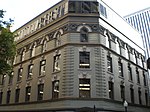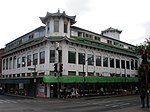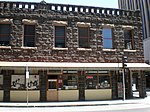Kumu Kahua Theatre
Kumu Kahua Theatre is a community theater located in the city of Honolulu on the island of Oahu in the state of Hawaii. Kumu Kahua Theatre is best known for producing plays by local Hawaii-based playwrights, especially plays featuring themes and stories of the people of Hawaii. (Their motto, as seen on their T-shirts and Web site, is "Plays about life in Hawaiʻi. Plays by Hawaiʻi playwrights. Plays for people of Hawaiʻi.") Therefore, actors are often featured utilizing their natural local dialect or respective ethnic accent, and many plays have incorporated or are solely written in Hawaiian Creole English, an English dialect commonly known in the Hawaiian islands as pidgin. Their productions are also known for involving local actors, designers, directors, and theater technicians. Appropriately the Hawaiian language words kumu kahua translate to "original stage." People familiar with the theatre often call it affectionately by its nickname of Kumu.
Excerpt from the Wikipedia article Kumu Kahua Theatre (License: CC BY-SA 3.0, Authors).Kumu Kahua Theatre
Nuuanu Avenue, Honolulu Chinatown
Geographical coordinates (GPS) Address Nearby Places Show on map
Geographical coordinates (GPS)
| Latitude | Longitude |
|---|---|
| N 21.3104 ° | E -157.8633 ° |
Address
The Nippu Jiji
Nuuanu Avenue
96808 Honolulu, Chinatown
Hawaii, United States
Open on Google Maps









